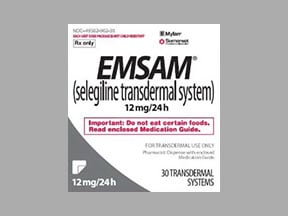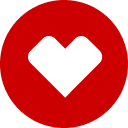
Emsam Coupons & Savings Card – Discount Prices from $2270.07
My prescription
Edit
12MG/24HR, Emsam (30 Patch 24 Hours)
Select pharmacy

CVS
$2270.07
COUPON PRICE
Walmart
$2318.59
COUPON PRICE
Walgreens
$2329.82
COUPON PRICE
Albertsons
$2351.09
COUPON PRICEEmsam savings card
Show this card to your pharmacist
CVS
$2270.07
BIN
ID
PCN
GRP
019876
LH30DAD2FF
CHIPPO
LHX
Powered by
Related MAOIs prescriptions
More prescriptions for depression
Related MAOIs prescriptions
More prescriptions for depression
Price history for Emsam
30 Patch 24 Hours, 12MG/24HR
Average retail price for Emsam
Average SaveHealth price for Emsam
Our price history data is based on aggregated prescription data collected from participating pharmacies in America. Our prescription data updates daily to reflect the latest price changes. If you notice a missing data point, it means there wasn't sufficient data available to generate a monetary value for that date.
*Retail prices are based on pharmacy claims data, and may not be accurate when we don't have enough claims.
Emsam dosage forms
Dosage Quantity Price from Per unit 6MG/24HR 1 Patch 24 Hour $58.93 $58.93 6MG/24HR 30 Patch 24 Hours $2270.07 $75.67 9MG/24HR 1 Patch 24 Hour $58.93 $58.93 9MG/24HR 30 Patch 24 Hours $2270.07 $75.67 12MG/24HR 30 Patch 24 Hours $2270.07 $75.67 12MG/24HR 1 Patch 24 Hour $58.93 $58.93
| Dosage | Quantity | Price from | Per unit |
|---|---|---|---|
| 6MG/24HR | 1 Patch 24 Hour | $58.93 | $58.93 |
| 6MG/24HR | 30 Patch 24 Hours | $2270.07 | $75.67 |
| 9MG/24HR | 1 Patch 24 Hour | $58.93 | $58.93 |
| 9MG/24HR | 30 Patch 24 Hours | $2270.07 | $75.67 |
| 12MG/24HR | 30 Patch 24 Hours | $2270.07 | $75.67 |
| 12MG/24HR | 1 Patch 24 Hour | $58.93 | $58.93 |
Emsam Warnings
Emsam (selegiline) patch is a medication used to treat depression, but it comes with important safety information that requires careful consideration. Below are the key warnings and precautions you need to be aware of:
Suicidal Thoughts and Behaviors: This medication may increase the risk of suicidal thoughts and behaviors in individuals, particularly those aged 24 and under. It is crucial to inform family members and caregivers about this risk so they can monitor for any changes in mood or behavior, particularly during the initial months of treatment or after a change in dosage. Contact your healthcare provider immediately if you experience any negative mood changes or thoughts of self-harm.
Dangerously High Blood Pressure: Emsam (selegiline) patch can cause dangerously high blood pressure, especially when consuming foods high in tyramine or when the dosage is 9 mg or higher every 24 hours. Avoid tyramine-rich foods and inform your healthcare provider of all medications you are taking, as some drugs can increase this risk. Seek emergency assistance if you experience severe symptoms such as chest pain, severe headache, rapid heartbeat, or light sensitivity.
Serotonin Syndrome: There is a risk of developing serotonin syndrome, a life-threatening condition caused by high serotonin levels, when taking Emsam (selegiline) patch alongside other medications that increase serotonin. Symptoms include agitation, hallucinations, confusion, and high body temperature. Ensure your healthcare provider is aware of all medications you are taking to avoid this risk.
Mania: In rare cases, this medication may trigger manic episodes in individuals with bipolar disorder or those with a family history of the condition. Symptoms may include extreme happiness, excitement, or delusions. Inform your healthcare provider if you have a personal or family history of bipolar disorder and seek immediate medical help if unusual behavior changes occur.
Contraindications:
- This medication should not be used by children under 12 years old.
- Do not use Emsam (selegiline) patch in conjunction with certain medications, such as SSRIs, SNRIs, and several others listed in the source material. Specific waiting periods are required before switching between these medications and Emsam (selegiline) patch.
- Individuals with a pheochromocytoma (a type of tumor) should not use this medication.
In the case of an overdose or serious side effects, seek emergency medical attention promptly. Always consult your healthcare provider for personalized advice and before making any changes to your medication regimen.
Emsam Side Effects
When using this medication, some common side effects may occur, but they are usually mild and manageable. These include dizziness, drowsiness, skin redness or irritation at the application site, tiredness, weakness, sleeping problems, constipation, dry mouth, headache, stomach upset, rash, and sinus swelling or infections. If any of these persist or worsen, it is advisable to consult a healthcare provider. In addition to the common side effects, some individuals may experience sexual dysfunction, weight changes, and low blood pressure. While these are less frequent, they should be monitored, and medical advice should be sought if they become problematic. There are rare but serious side effects that necessitate immediate medical attention. These include the risk of serotonin syndrome, which can present with symptoms such as agitation, hallucinations, confusion, fast heart rate, sudden changes in blood pressure, sweating, high body temperature, tremor, and muscle jerks. Another critical condition to be aware of is dangerously high blood pressure, marked by severe headaches, chest pain, fast or irregular heartbeat, stiff neck, nausea, vomiting, and sensitivity to light. Although very rare, allergic reactions to this medication can occur. Signs include rash, itching, swelling (especially of the face, tongue, or throat), dizziness, and breathing difficulties. Prompt medical help should be sought if any serious allergic reaction symptoms are noticed. If other side effects not listed here are observed, contacting a healthcare provider for advice is recommended.
Emsam Interactions
When using Selegiline, it is crucial to be aware of potential drug interactions. This medication can interact with several types of drugs, including certain antidepressants like bupropion, Mirtazapine, and specific SSRIs, SNRIs, and TCAs. It also interacts with other MAO inhibitors such as isocarboxazid, moclobemide, and Tranylcypromine. Additionally, drugs for attention deficit disorder (e.g., Atomoxetine, Methylphenidate), appetite suppressants (e.g., Diethylpropion), and some migraine medications (e.g., Rizatriptan, Sumatriptan) may cause interactions.
Such interactions can increase the risk of serotonin syndrome, a potentially serious condition characterized by high levels of serotonin in the body. Symptoms can include confusion, hallucination, and rapid heart rate. Street drugs like MDMA, certain opioids (e.g., Tramadol, methadone), and supplements like St. John's wort can also elevate this risk.
If you are taking any of these medications or supplements, inform your healthcare provider before starting or stopping selegiline. It's particularly important to discuss the timing when switching to or from selegiline, especially if you have recently taken Fluoxetine, as you may need to wait at least five weeks.
Furthermore, if you use higher strength selegiline patches, dietary restrictions are necessary to limit tyramine intake, as high tyramine levels can lead to dangerous spikes in blood pressure. Avoid aged cheeses, processed meats, and certain alcoholic beverages. Your doctor or dietician can provide specific dietary advice.
Finally, this medication might interfere with certain lab tests, so ensure all medical professionals involved in your care are aware of your selegiline usage. If you experience symptoms of high blood pressure, such as severe headache or chest pain, seek medical attention immediately.
What does EMSAM do to the brain?
EMSAM is a transdermal patch that delivers selegiline, a monoamine oxidase inhibitor (MAOI), into the body. It works by inhibiting the enzyme monoamine oxidase, which is responsible for breaking down neurotransmitters such as serotonin, norepinephrine, and dopamine in the brain. By preventing the breakdown of these neurotransmitters, EMSAM helps to increase their levels, which can improve mood and alleviate symptoms of depression.
What is the EMSAM used for?
EMSAM is a transdermal patch used to treat major depressive disorder in adults. It contains the active ingredient selegiline, which is a type of monoamine oxidase inhibitor (MAOI).
Does EMSAM help anxiety?
EMSAM, which is a transdermal patch containing the medication selegiline, is primarily used to treat major depressive disorder. While it is not specifically approved for the treatment of anxiety disorders, some patients with depression who also experience anxiety may find relief in their anxiety symptoms as their depression improves. However, it is important for patients to consult with their healthcare provider to determine the most appropriate treatment for their specific condition.
What are the benefits of EMSAM?
EMSAM, a transdermal patch containing the active ingredient selegiline, is primarily used to treat major depressive disorder. The benefits of EMSAM include:1. Convenience: As a patch, it provides a continuous delivery of medication, which can be more convenient than taking daily oral medications.2. Reduced Side Effects: The transdermal delivery system may result in fewer gastrointestinal side effects compared to oral antidepressants.3. No Dietary Restrictions at Lower Doses: At lower doses, EMSAM does not typically require dietary restrictions, unlike oral MAOIs, which can interact with certain foods.4. Efficacy: It can be effective for individuals who have not responded to other antidepressant treatments.Patients should consult with their healthcare provider to determine if EMSAM is appropriate for their specific condition.
What is the mechanism of action of EMSAM?
EMSAM (selegiline transdermal system) is a monoamine oxidase inhibitor (MAOI). Its mechanism of action involves the inhibition of the enzyme monoamine oxidase type B (MAO-B) in the brain. By inhibiting this enzyme, EMSAM increases the levels of certain neurotransmitters, such as dopamine, norepinephrine, and serotonin, which can help improve mood and alleviate symptoms of depression.
